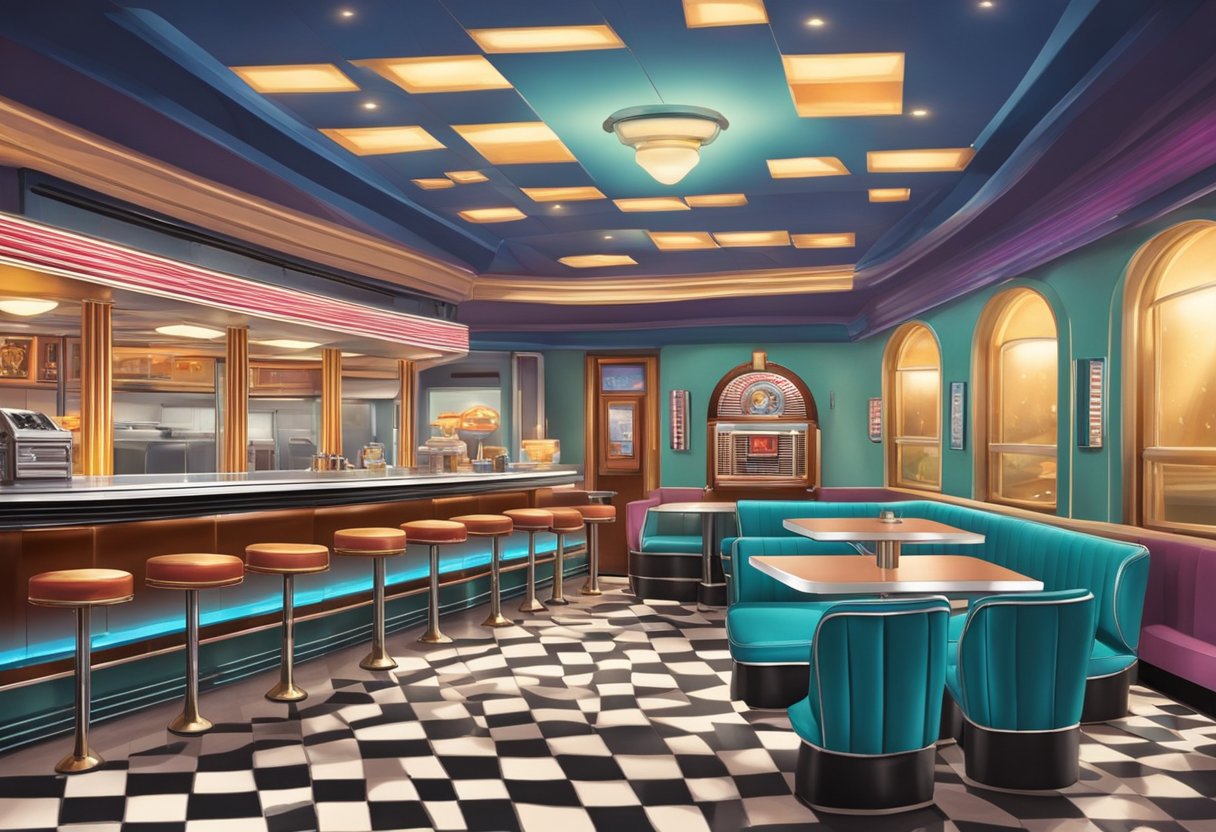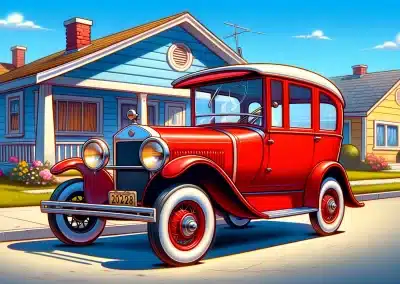Rockin’ Eats: Celebrating Jukeboxes and Their Role in Diner Culture. Step into any diner with a jukebox and you’re instantly transported to a bygone era of rock & roll and milkshakes. These music machines are much more than just an accessory; they’re central to the diner experience, offering a tangible slice of nostalgia that complements the aroma of coffee and the clatter of cutlery. Jukeboxes in diners evoke memories of the ’50s and ’60s, when teens in poodle skirts and leather jackets would select their favorite tunes while sharing a soda.

The enduring appeal of jukeboxes rests not only in the music they play but also in the cultural touchstone they represent. The sight and sound of a jukebox playing classics from Elvis Presley to The Beatles forms an ambient backbone to the dining experience, creating an atmosphere that is at once intimate and communal. These machines have weathered the tides of change, from vinyl to digital, reflecting the shifts in how society consumes music while maintaining their status as icons of Americana.
Key Takeaways
- Jukeboxes are iconic fixtures in diners, enhancing the experience with a sense of history.
- They represent an era where music and dining created communal cultural experiences.
- Despite technological changes, jukeboxes remain a beloved part of the diner ambiance.
The Evolution of Jukeboxes
As one traces the lineage of the jukebox, from its inception as a coin-operated phonograph to the contemporary digital jukebox, they encounter a rich tapestry woven with innovation, iconic brands, and the undying human desire to enjoy music communally.
From Edison to Digital
Thomas Edison’s invention of the phonograph in the late 19th century set the stage for the first iteration of the jukebox. It was Louis Glass who, in 1889, implemented the coin-operated mechanism on an Edison phonograph, creating what was then known as a nickel-in-the-slot player. As technology advanced, the phonograph evolved to play vinyl records, opening up a world of music possibilities.
With each leap in music media—from cassette tapes to compact discs—jukeboxes mirrored this progress, becoming capable of playing the latest formats. The traditional tactile experience of flipping through a jukebox’s selections gave way to the digital age, where touchscreen interfaces and vast digital libraries became the norm.
Iconic Brands and Models
Several key players have left indelible marks on jukebox history. Wurlitzer, AMI, Seeburg, and Rock-Ola are brands that have become synonymous with this beloved machine. In particular, the Seeburg M100C, unveiled in 1953, stands out for its stylish design and technological strides, becoming a staple in pop culture.
Each brand brought something unique, whether it was Wurlitzer’s ‘bubble tubes’ and colorful lights, AMI’s varying wood finishes and smooth curves, or Rock-Ola’s contribution to both the classic and modern innovative jukebox scenes in the UK, hinting at the equipment’s versatile nature in adapting to the cultural backdrop.
Through these brands and models, jukeboxes have not only showcased the history of music but have also given it a physical, interactive form—an embodiment of the tunes that have shaped eras and enlivened diners and pubs around the world.
Diners and Jukeboxes: A Blend of Culture and Charm
Diners and jukeboxes symbolize an era where delicious comfort food and the joy of music came together, creating a hub for both locals and tourists. This blend has remained a cherished part of American culture.
The Rise of Diner Culture
In the early 20th century, diners emerged as an accessible venue for a quick and hearty meal, a place where a waitress would greet you with a smile and a coffee refill was never far away. Originating in the Northeastern United States, with New Jersey often credited as the birthplace of the classic diner, these prefabricated eateries served as beacons of socialization. They were frequented by a variety of patrons, from blue-collar workers to night owls.
Diner Menu Offerings:
- Breakfast: Eggs, pancakes, and waffles served all day.
- Lunch and Dinner: Burgers, sandwiches, and the classic pizza slice.
- Beverages: Milkshakes, sodas, and the comforting mug of hot coffee.
Jukebox Aesthetics and Nostalgia
The jukebox, often found nestled in the corner booth of a 1950s-themed diner, is more than just an entertainment machine; it’s a portal to the past. Each vinyl record spun within these illuminated cabinets carried tunes that defined generations. Jukeboxes evolved from simple bubblers to intricate designs with eye-catching colors and bright lights, invoking nostalgia for the simplicity and charm of bygone days.
Notable Jukebox Features:
- Playlist: From Elvis to The Beatles, the selection reflected the popular hits of the day.
- Design: Art Deco and chrome finishes that shone against the diner’s ambiance.
Each diner visit offered a multisensory experience, combining the taste of a handmade pizza or a fluffy omelet from the diner menu with the auditory backdrop of a favorite hit whirling from the jukebox. This atmosphere proved irresistible to tourists and locals alike, turning diners into must-visit spots in places like San Francisco, which, during the Prohibition era, hosted speakeasies that later evolved into diners.
Jukeboxes themselves have spanned a journey, from their debut beside the early diners of the 20th century to their place in modernity as a cherished emblem of the 1950s. Whether one is enjoying breakfast in a cozy booth or a late-night snack among friends, the jukebox stands as a timeless testament to the era’s charm.
The Business of Jukeboxes
The enduring appeal of jukeboxes in diners hinges on their ability to attract customers with the allure of accessible music entertainment. Even in today’s digital age, the classic coin-operated machines have a nostalgic charm that can increase a diner’s profits.
Profiting from Music Entertainment
Jukeboxes have long been a feature in diners, providing patrons with the enjoyment of music selection while hanging out with friends and family. These machines were strategic investments for business owners, transforming a simple meal into an interactive experience. By inserting coins, customers could choose their favorite tracks, creating a personalized soundtrack for their dining experience. This function turned music into a source of revenue, contributing to the establishment’s profit beyond food and drink sales.
Digital Solutions in Modern Times
Today, digital jukebox systems like TouchTunes have modernized the jukebox business model. By utilizing apps and mobile app technology, customers can now select and play music directly from their smartphones. This innovation maintains the communal and interactive elements of traditional jukeboxes while offering a wider range of music selections and convenience to users. For business owners, these digital systems can translate into higher customer engagement and, by extension, increased profits as the convenience of song selection via a few taps on a screen enhances the overall dining experience.
Maintenance and Preservation

Maintenance and preservation of jukeboxes are crucial for keeping these intriguing pieces of history alive. Whether it’s a classic Wurlitzer or a sleek Rock-Ola, proper care ensures their operational longevity and aesthetic allure, particularly for collectors fascinated by music from the past.
The Art of Restoring Vintage Jukeboxes
Restoring vintage jukeboxes is a meticulous process that involves both technical skill and a deep appreciation for historical accuracy. Collectors and restorers often seek out original parts and employ period-correct techniques to maintain the authenticity of these machines. For instance, a Wurlitzer from the 1940s requires specific components that are as true to the original as possible, making the hunt for these items a crucial part of the restoration journey. Restoring not only revitalizes the jukebox for continued use but also helps in preserving a slice of musical history for future generations.
The Shift to Digital and Its Impact
The transition into the digital age has significantly affected how jukeboxes operate and are maintained. Many modern jukeboxes have integrated digital interfaces and compact discs, reflecting the contemporary demand for digital convenience. This shift presents unique preservation challenges, as the original analog charm can be lost. However, the digital adaptability of brands like Rock-Ola ensures that the essence of the classic jukebox endures, blending vintage appeal with modern technology, and appealing to both long-time collectors and new enthusiasts drawn to the nostalgic charisma of these music machines.
Conclusion

Jukeboxes remain a beloved staple in diners, sparking joy with their classic aesthetics and the entertainment they provide. They are more than music players; they are collectors’ items and symbols of nostalgia that transport individuals back to a golden era. Diners with a jukebox at the corner become time capsules, offering a unique dining experience coupled with a melodious journey through time.
The collecting of jukebox models has become a passionate endeavor for many, each machine holding a story in its vintage framework. These music boxes are a testament to the enduring legacy of physical media in an increasingly digital world. Their tactile nature and the visual charm add an extra layer of appeal to the diner atmosphere.
As entertainment gadgets, they have evolved from simple coin-operated devices to complex machines capable of streaming digital music, yet the affection for original vinyl-playing jukeboxes hasn’t waned. Their presence in diners remains a strong draw for those hungry for both comfort food and soulful tunes.
In conclusion, the nostalgia associated with jukeboxes is a powerful force. These icons of musical history have weathered the storm of time, proving their value goes beyond mere aesthetics. They continue to be a source of communal enjoyment and individual reflection, keeping the soundtrack of bygone days alive in the hearts of many.







